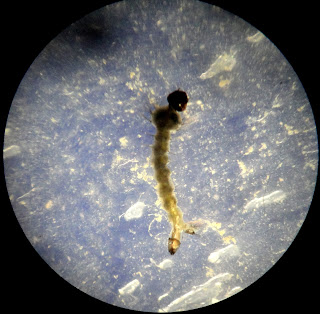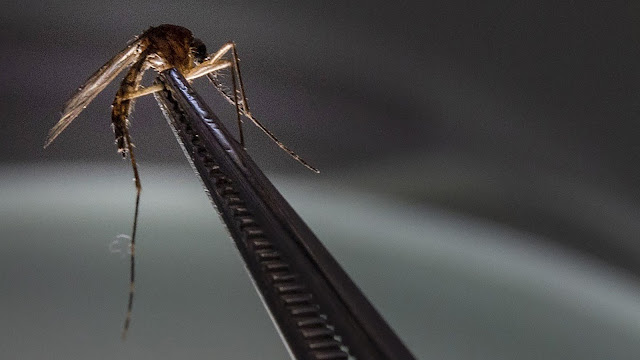A War Against Malaria: Recent Cases Echo Nation’s Battle with Anopheles Mosquito
Dr. Kevin Taylor explains that the recent cases of locally acquired malaria in the U.S. are isolated incidents, with a low risk for the general population, and emphasizes the availability of effective treatments, providing hope that public health measures can quickly contain such occurrences despite possible factors like climate change and increased travel.
September 19, 2023 by Ian Neligh
For the first time in 40 years, a resident living in the Washington, D.C., area tested positive for malaria from what is presumed to be a locally acquired infection.
Uniformed Services University of the Health Sciences (USU).“There was one case in Maryland, in a region where millions of people live, and so far there’s no evidence that there's additional transmission,” says Taylor. “This means the risk is very low for the average person living in this area and it's quite possible this is the only case that's going to occur.”
Taylor says that even though the malaria parasite was somehow introduced into the Anopheles mosquito population, it appears unlikely that there is sustained transmission afterwards.
“So this could be the end of it,” says Taylor, who is also the director of the Division of Global Public Health at the university’s Department of Preventive Medicine and Biostatistics. “But there’s still a need for enhanced surveillance, just to be sure.”
With this recent case in August, Maryland joined Florida who reported seven cases of locally-acquired malaria earlier this year, and Texas who reported one — both for the first time in two decades. While nearly 2,000 cases of travel-related malaria are diagnosed in the U.S. each year, locally-acquired cases are quite rare.
According to the Centers for Disease Control and Prevention (CDC), malaria is one of the biggest health concerns in the world, infecting approximately 240 million people each year and causing an estimated 660,000 deaths — mostly in Africa.
“There are parts of the world, especially sub-Saharan Africa, where malaria is quite common, and still causes hundreds of thousands of deaths a year,” says Taylor. “But here in the United States, we no longer have what we would characterize as endemic malaria, meaning malaria that is persistent, causing cases year after year due to ongoing transmission.”
In the late 1940s, the U.S. took the lessons it learned during World War II and fought a tactical battle against the infective Anopheles mosquito, all but eradicating it. But there is a hypothesis that with warming global temperatures the malaria parasite could make a return.
At War
During the Second World War, Taylor says there was a recognition that malaria was significantly impacting U.S. troops, both in the deployed setting and at training installations here at home.
“There was a concerted effort to combat malaria at these bases where our troops were located, and they demonstrated success by controlling the mosquitoes that spread malaria, “ says Taylor. “Draining mosquito breeding areas close to our military bases, and the spraying of insecticide allowed them to eliminate the mosquito vector.”
Those tactics proved useful during the war and after the troops returned it was decided to implement the same program across the United States where malaria was affecting civilian populations.
 |
Here Lt. Joseph W. Diclaro II, a medical entomologist with the Public Health and Preventive Medicine Detachment, Alpha Surgical Company, 2nd Marine Logistics Group, observes through a microscope mosquitoes and larvae collected in Afghanistan. (Photo courtesy of II Marine Expeditionary Force) |
“It was not uncommon for people in the southeast to get malaria in the 19th and early part of the 20th Century,” Taylor says. “Fortunately, the type of malaria we typically saw here in the United States at that time was a less severe form of malaria.”
The Office of Malaria Control in War Areas, the predecessor to the CDC, was established in 1942. In 1947, 15,000 cases of malaria were reported. In three short years, that number dropped to 2,000 and just a year later malaria was considered eliminated from the country.
“In less than a decade, they were able to eliminate malaria in the U.S. through the use of habitat control and spraying of insecticide,” Taylor says. “It was one of the great public health successes of that time period.”
Surveillance
Since its initial elimination, malaria hasn't been able to regain a foothold in this country despite the isolated instances.
“These cases we've seen recently here in Maryland and the ones in Texas and Florida, represent sporadic introductions of malaria into the United States and are likely from a traveler who came from a part of the world where there was malaria,” Taylor says. “They likely were bit by a mosquito here in the United States, and then that mosquito went on to bite someone else and infect them.”
Taylor says the public health measures taken were effective, or the chain of transmission was somehow broken through natural means.
“We haven't heard of any additional cases, so hopefully that means the chain of transmission has been broken here (in Maryland) as well,” Taylor says.
He adds that it is interesting that decades have passed since the last reported locally-acquired infections in the U.S., but now suddenly there were several occurring all within months of each other.
“Is it just a chance occurrence, a clustering of unrelated infections? There are hypotheses about other factors that may increase the likelihood of these kinds of events occurring,” Taylor says. “With post-COVID international travel ramping up again—are we just getting more and more introductions of cases here in the United States from people that are traveling internationally? That perhaps is part of it.”
He says another hypothesis is that climate change is starting to have more of an impact on the distribution and risk of certain vector-borne diseases spread by ticks and mosquitoes.
“The possibility is that with climate change, warmer weather and higher humidity in certain parts of the country are giving these mosquitoes a broader habitat to live in,” Taylor says.
A changing climate may also improve the survivability of the malaria parasite in certain regions. When a mosquito is infected with the malaria parasite, it needs to undergo further development inside the mosquito before it can be transmitted to a human, a process that can take several days.
“In a place like Maryland,” says Taylor, “mosquitoes typically don't survive long enough for that to happen. But higher temperatures and higher humidity can extend the lifespan of mosquitoes, thereby creating conditions where malaria can be transmitted from person to mosquito to person where before perhaps it couldn’t.”
Taylor says that hypothesis could explain why so many locally-acquired malaria cases occurred this year and suggests that it might be seen more often in the future.
“Maryland Department of Health is conducting enhanced mosquito surveillance, which means they collect mosquitoes from the environment and test to see if any of them have the malaria parasite,” Taylor says, adding today, that when properly diagnosed, there are good treatments that can easily cure someone with malaria. “ … I think we'll wait and see if anything else pops up, but fortunately we do have very well-established public health tools available to us to act quickly when we do see a vector-borne disease like this emerge.”







